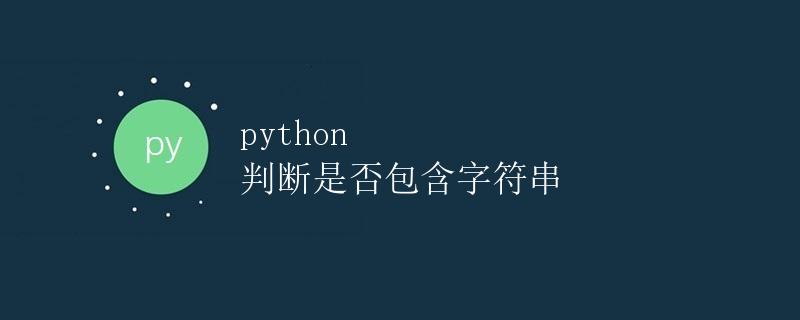python 判断是否包含字符串

在日常的编程工作中,我们经常会碰到需要判断一个字符串是否包含另一个字符串的情况。Python作为一种流行的编程语言,提供了多种方法用于判断字符串之间的包含关系。本文将详细解释在Python中如何判断一个字符串是否包含另一个字符串。
使用in关键字
Python中最简单的方法来判断一个字符串是否包含另一个字符串是使用in关键字。in关键字用于判断一个字符串是否包含在另一个字符串中,如果包含则返回True,否则返回False。
下面是一个简单的示例代码:
str1 = "hello world"
str2 = "hello"
str3 = "python"
print(str2 in str1) # 返回True
print(str3 in str1) # 返回False
运行结果如下:
True
False
在上面的示例中,我们定义了两个字符串str1和str2,分别为”hello world”和”hello”。使用in关键字判断str2是否包含在str1中,结果为True。而str3为”python”,判断str3是否包含在str1中,结果为False。
使用find方法
除了使用in关键字,Python还提供了字符串对象的find方法来判断一个字符串是否包含另一个字符串。find方法用于在字符串中查找子字符串,如果找到则返回子字符串的起始位置,否则返回-1。
下面是一个示例代码:
str1 = "hello world"
str2 = "hello"
str3 = "python"
print(str1.find(str2)) # 返回0
print(str1.find(str3)) # 返回-1
运行结果如下:
0
-1
在上面的示例中,我们使用find方法判断str2和str3分别在str1中的位置。结果为0表示str2在str1中的起始位置为0,而-1表示str3不在str1中。
使用index方法
除了find方法,Python还提供了字符串对象的index方法来判断一个字符串是否包含另一个字符串。index方法与find方法类似,用于在字符串中查找子字符串,如果找到则返回子字符串的起始位置,否则会抛出ValueError异常。
下面是一个示例代码:
str1 = "hello world"
str2 = "hello"
str3 = "python"
print(str1.index(str2)) # 返回0
try:
print(str1.index(str3))
except ValueError:
print(f"{str3} not found in {str1}")
运行结果如下:
0
python not found in hello world
在上面的示例中,我们使用index方法判断str2和str3分别在str1中的位置。结果为0表示str2在str1中的起始位置为0,而由于str3不在str1中,会抛出ValueError异常。
使用startswith和endswith方法
除了上述方法,Python还提供了字符串对象的startswith和endswith方法来判断一个字符串是否以指定的子字符串开头或结尾。startswith用于判断字符串是否以指定子字符串开头,而endswith用于判断字符串是否以指定子字符串结尾,返回结果均为True或False。
下面是一个示例代码:
str1 = "hello world"
prefix = "hello"
suffix = "world"
str2 = "python"
print(str1.startswith(prefix)) # 返回True
print(str1.endswith(suffix)) # 返回True
print(str1.endswith(str2)) # 返回False
运行结果如下:
True
True
False
在上面的示例中,我们使用startswith方法判断str1是否以prefix为开头,结果为True。使用endswith方法判断str1是否以suffix为结尾,结果同样为True。而由于str2不在str1中,所以结果为False。
使用正则表达式
在实际开发中,有时我们需要更灵活的方式来判断字符串是否包含指定的子字符串。这时候可以使用正则表达式来实现复杂的匹配规则。Python标准库中的re模块提供了对正则表达式的支持,可以用于判断字符串是否满足特定的模式。
下面是一个示例代码:
import re
str1 = "hello world"
pattern = r"hello"
str2 = "python"
if re.search(pattern, str1):
print(f"{str1} contains '{pattern}'")
else:
print(f"{str1} does not contain '{pattern}'")
if re.search(pattern, str2):
print(f"{str2} contains '{pattern}'")
else:
print(f"{str2} does not contain '{pattern}'")
运行结果如下:
hello world contains 'hello'
python does not contain 'hello'
在上面的示例中,我们使用正则表达式r"hello"来匹配字符串str1和str2。由于str1中包含”hello”,所以第一个判断结果为包含。而str2中不包含”hello”,所以第二个判断结果为不包含。
总结
本文详细解释了在Python中判断字符串是否包含另一个字符串的多种方法,包括使用in关键字、find方法、index方法、startswith和endswith方法以及正则表达式。选择合适的方法取决于具体的需求,读者可以根据自己的实际情况选择最合适的方法来判断字符串之间的包含关系。
 极客教程
极客教程